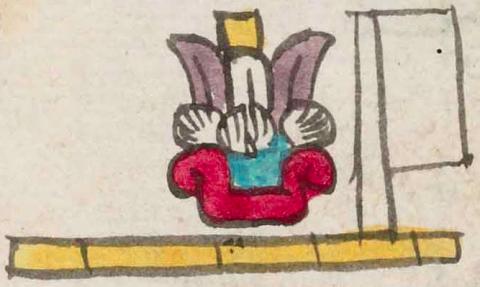Acapan (Mdz20r)
This compound glyph for the place name Acapan has three prominent elements. One is the central shape of the calendrical reed-arrow (acatl), decorated with feathers, standing in the small water channel (apantli), which contains turquoise blue water and is outlined in red. This one element fully covers the name Acapan, if the viewer is willing to recognize the -apan that is built into the calendrical glyph for acatl. But the painter has provided additional elements to ensure the proper reading. There is a phonetic complement of acatl in the form of a long, yellow, bamboo-like reed running horizontally at the bottom of the grouping. And, standing upright along the right edge of the grouping, there is a banner (panitl) with a white stick and a white, narrow, rectangular flag, which serves as a phonetic complement for the locative suffix -pan or, if the -apan is ignored, provides the logograph "pan" (flag, banner) that finally provides the suffix.
Stephanie Wood
This compound glyph is more complex than many of the place names in the Codex Mendoza, which can be simple, paired logograms. It appears to two phonetic complements that reinforce or help disambiguate the reading.
Stephanie Wood
acapan. puo
Acapan, pueblo
Stephanie Wood
c. 1541, or by 1553 at the latest
Stephanie Wood
The four parts include two examples of acatl, plus the apantli, and the panitl.
The reading order is complex. The acatl, reed, that lies horizontally along the bottom could be the starting place, but, above that, there is also an acatl (reed-arrow) that is vertical. The water channel, apantli, with its turquoise or blue-green water, intervenes between the two reeds. And on the right there is the panitl, flag, which adds another emphasis to the pan sound.
reeds, rushes, canes, flags, arrows, darts, water, feathers, plumas, tules, carrizos, nombres de lugares

aca(tl), reed-arrow, cane, https://nahuatl.wired-humanities.org/content/acatl
a(tl), water, https://nahuatl.wired-humanities.org/content/atl
apan(tli), water channel or canal, https://nahuatl.wired-humanities.org/content/apantli
pan(itl), banner, https://nahuatl.wired-humanities.org/content/pamitl
-apan (locative suffix), on or at the waters of, https://nahuatl.wired-humanities.org/content/apan-0
a(tl), water, https://nahuatl.wired-humanities.org/content/atl
-pan (locative suffix), on, https://nahuatl.wired-humanities.org/content/pan
tlateloloyo(tl), down feathers, https://nahuatl.wired-humanities.org/content/tlateloloyotl
mi(tl), arrow, dart, https://nahuatl.wired-humanities.org/content/mitl
"On the Reeds" (Berdan and Anawalt, 1992, v. 1, p. 167)
ACA2ACAACA3-APANpan [Whittaker, Deciphering Aztec Hieroglyphs, 2021, 186]
Codex Mendoza, folio 20 recto, https://digital.bodleian.ox.ac.uk/objects/2fea788e-2aa2-4f08-b6d9-648c00..., image 50 of 188.
The Bodleian Libraries, University of Oxford, hold the original manuscript, the MS. Arch. Selden. A. 1. This image is published here under the UK Creative Commons, “Attribution-NonCommercial-ShareAlike 3.0 License” (CC-BY-NC-SA 3.0).



